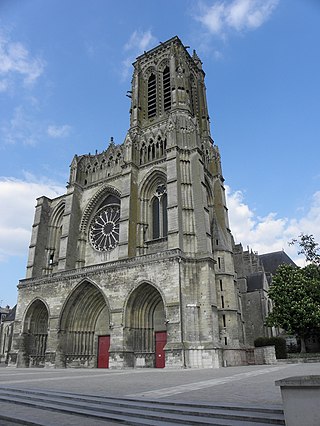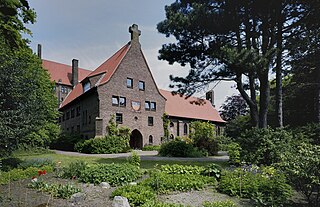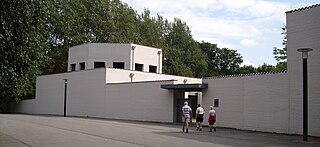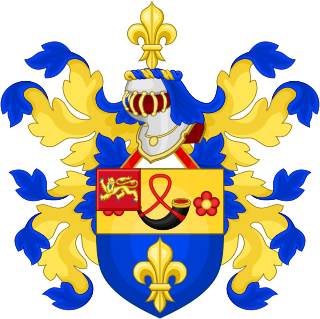
Gaspar de Crayer or Jasper de Crayer was a Flemish painter known for his many Counter-Reformation altarpieces and portraits. He was a court painter to the governors of the Southern Netherlands and worked in the principal cities of Flanders where he helped spread the Rubens style.

The Diocese of Soissons, Laon, and Saint-Quentin is a Latin Church diocese of the Catholic Church in France. The diocese is suffragan to the Archdiocese of Reims and corresponds, with the exception of two hamlets, to the entire Department of Aisne. The current bishop is Renauld Marie François Dupont de Dinechin, appointed on 30 October 2015. In 2022, in the Diocese of Soissons there is one priest for every 5,594 Catholics.

Egmond Abbey or St. Adalbert's Abbey is a Benedictine monastery of the Congregation of the Annunciation, situated in Egmond-Binnen, in the municipality of Bergen, in the Dutch province of North Holland. Founded in 920-925, and destroyed during the Reformation, it was re-founded in 1935 as the present Sint-Adelbertabdij, in the Diocese of Haarlem.

Herkenrode Abbey was a Catholic monastery of Cistercian nuns located in Kuringen, part of the municipality of Hasselt, which lies in the province of Limburg, Belgium.

Forest Abbey or Vorst Abbey was a Benedictine abbey located in the Brussels municipality of Forest, Belgium. It was founded in 1105 and existed for nearly 700 years, until its partial destruction by fire in 1764. It was abolished in 1796. Only the abbey's 18th-century outbuildings have been preserved. They are now owned by the municipality and serve as a cultural centre.

Vilain and Vilain XIIII is a Belgian noble family. Their coat of arms is basically "Sable, on a chief argent a label of the field", a colour scheme that is present from the earliest Vilains in the 15th century, and is also seen in the Vilain XIIII arms, which have the "XIIII" added to it.

Jean de Wachtendonck, Latinized Joannes (1592–1668) was the eighth bishop of Namur, in the Spanish Netherlands.

Male Castle, Bruges. A community of the Canonesses Regular of the Holy Sepulchre. It originated in Bruges in the 11th century, and between 1954 and 2013 was settled in Male Castle in Male, Sint-Kruis, Bruges, West Flanders, Belgium.

Roosenberg Abbey was established in 1238 at Waasmunster, halfway between Ghent and Antwerp. The abbey is still operating at Waasmunster, though not on its original site. Its 750-year history has not been uninterrupted.

Ten Duinen Abbey or the Abbey of the Dunes was a Cistercian monastery at Koksijde in what is now Belgium. It was one of the richest and most influential religious institutions in the medieval County of Flanders. It later relocated from Koksijde to the city of Bruges.

Oosteeklo is a historic village in the Flemish province of East Flanders, Belgium, which since 1977 has been a subdivision of the municipality of Assenede. The village is situated 9 km east of Eeklo and 17 km north of Ghent, about 9 km from the border with the Netherlands, and lies approximately 9 metres above sea-level.
Joanna de Hertoghe was an abbess of the Cistercian Oosteeklo Abbey in Ghent.

The Rubens family is a Flemish noble family that lived in Antwerp.

Jooris van der Straeten, known as Jorge de la Rúa in Spain and in France as Georges van der Straeten, was a Flemish portrait and history painter. Originally from Ghent, he travelled abroad and became portrait painter to the ruling houses in Portugal, Spain and France. A polyglot, van der Straeten was a versatile courtier, who worked primarily as a portraitist for queens.
The Maetschappy der Vlaemsche Bibliophilen, in its later years Maatschappij der Vlaamsche Bibliophilen was a text publication society based in Ghent, Belgium. The society was founded by Philip Blommaert and Constant-Philippe Serrure in 1839 to produce editions of medieval Flemish literature. It was active until 1909. By current scholarly standards, the quality of the editions shows little palaeographical and codicological expertise.
Bernardusdal Abbey was a house of Cistercian nuns originally established just outside Diest in the Duchy of Brabant, and later within the walls of the town itself.

The Cistercian Abbey of Roermond or Munsterabdij was a Cistercian nunnery in Roermond that existed from 1224 to 1797 and of which the Munsterkerk is the only physical remnant.
Events in the year 1631 in the Spanish Netherlands and Prince-bishopric of Liège.
Events in the year 1630 in the Spanish Netherlands and Prince-bishopric of Liège.















